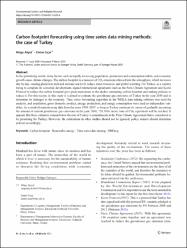| dc.contributor.author | Akyol, Müge | |
| dc.contributor.author | Uçar, Emine | |
| dc.date.accessioned | 2021-06-09T08:23:17Z | |
| dc.date.available | 2021-06-09T08:23:17Z | |
| dc.date.issued | 2021 | en_US |
| dc.identifier.citation | Akyol, M., & Uçar, E. (2021). Carbon footprint forecasting using time series data mining methods: the case of Turkey. Environmental science and pollution research international, 1–11. Advance online publication.
https://doi.org/10.1007/s11356-021-13431-6 | en_US |
| dc.identifier.uri | https://doi.org/10.1007/s11356-021-13431-6 | |
| dc.identifier.uri | https://hdl.handle.net/20.500.12508/1745 | |
| dc.description.abstract | In the globalizing world, many factors such as rapidly increasing population, production and consumption habits, and economic growth cause climate changes. The carbon footprint is a measure of CO2 emissions released into the atmosphere, which increases day by day, causing glaciers to melt and increase sea level, reduce water resources, and global warming. For Turkey, as a country trying to complete its economic development, signed international agreements such as the Paris Climate Agreement and Kyoto Protocol to reduce the carbon footprint give great importance to the studies estimating carbon footprint and making policies to reduce it. For this reason, in this study it is aimed to estimate the greenhouse gas emissions of Turkey in the year 2030 and to determine its damages to the economy. Time series forecasting algorithm in the WEKA data mining software was used for analysis, and population, gross domestic product, energy production, and energy consumption were used as independent variables. As a result of analysis using data from the years 1990-2017, as long as Turkey continues its course of gradually increasing the amount of current greenhouse gas emissions in the year 2030, 728.3016 metric tons of CO2 equivalent will be reached. It appears that these estimates remain below the rate of Turkey's commitments at the Paris Climate Agreement that is considered to be promising for Turkey. However, the estimations in other studies should not be ignored; policy makers should determine policies accordingly. | en_US |
| dc.language.iso | eng | en_US |
| dc.publisher | Springer | en_US |
| dc.relation.isversionof | 10.1007/s11356-021-13431-6 | en_US |
| dc.rights | info:eu-repo/semantics/openAccess | en_US |
| dc.subject | Carbon footprint | en_US |
| dc.subject | Renewable energy | en_US |
| dc.subject | Time series data mining | en_US |
| dc.subject | SMOreg | en_US |
| dc.subject.classification | Environmental Kuznets Curve | |
| dc.subject.classification | Financial Development | |
| dc.subject.classification | Trade Openness | |
| dc.subject.classification | Environmental Sciences | |
| dc.title | Carbon footprint forecasting using time series data mining methods: the case of Turkey | en_US |
| dc.type | article | en_US |
| dc.relation.journal | Environmental Science and Pollution Research | en_US |
| dc.contributor.department | İşletme ve Yönetim Bilimleri Fakültesi -- Lojistik Yönetimi Bölümü | en_US |
| dc.contributor.department | İşletme ve Yönetim Bilimleri Fakültesi -- Yönetim Bilişim Sistemleri Bölümü | |
| dc.relation.publicationcategory | Makale - Uluslararası Hakemli Dergi - Kurum Öğretim Elemanı | en_US |
| dc.contributor.isteauthor | Akyol, Müge | |
| dc.contributor.isteauthor | Uçar, Emine | |
| dc.relation.index | Web of Science - Scopus - PubMed | en_US |
| dc.relation.index | Web of Science Core Collection - Science Citation Index Expanded | |
















